

 |
 |
|
![]()
Recommended restoration actions
Increased flows
Water temperature
False attraction and straying
Fish passage
Gravel Enhancement
Control of Disease Transmission
A
Classification System Used to Qualify Maximum Potential Restored Fish Habitat
In Stream Reaches Of Battle Creek
![]()
Early fisheries workers recognized Battle Creek as one of the most significant
salmon producing streams in the Central Valley. It is one of the only streams
in the Sacramento River basin that harbors four runs of chinook salmon. The
abundant water supply in the watershed and steep stream gradient also made Battle
Creek attractive for hydropower development . Access to the upper basin for
salmon and steelhead has been blocked by small hydro projects for most of this
century.
While fall run and late-fall run chinook have thrived in lower Battle Creek, winter run and spring run chinook salmon and steelhead runs have been diminished. During the last 20 years, access to the basin was further restricted by a weir at Coleman National Fish Hatchery. There was concern that fish diseases might be introduced to the hatchery's water supply if wild fish were allowed to go upstream.
The Battle Creek Work Group
(BCWG) Biological Team, a group of fisheries scientists from agencies and private
interests, assisted Kier Associates in crafting the Restoration Plan by developing
the following criteria for restoration:
|
|
|
|
Restoration actions will greatly enhance 42.5 miles of habitat and should increase all salmon and steelhead runs. Steelhead escapement is expected to increase the most under restored conditions. It is predicted that the adult steelhead population will increase by 5,700, which will more than double the average run to the entire Sacramento River above Red Bluff. The gain of 2,500 adult winter and spring run chinook salmon would also appreciably increase the total run size of these species. Improvement in fall and late fall chinook salmon returns would be proportionally much less significant.
Expected Increase in
Escapement of Salmon and Steelhead Runs Under Restored Conditions
|
|
|
|
|
|
|
|
|
|
|
|
|
|
|
![]()
Recommended restoration actions
The restoration activities suggested in the Battle Creek Salmon and Steelhead Restoration Plan include increasing fish habitat through flow augmentation, decreasing water temperature and improving fish passage. Modifications in hydropower operation are expected to decrease straying and allow less restricted movement of spawning gravels. Changes in diversion strategy will also insure a water supply for Coleman Hatchery that has low disease risk in the event of mechanical failure of the hatchery's ozonation system.
Note: All recommendations
in the Plan are preliminary, final measures will be negotiated by government
agents and Pacific Gas and Electric.
|
Several past restoration plans have recommended flow increases in Battle Creek (CDFG 1990, Bernard et al. 1996, McEwan and Jackson 1996). The Battle Creek Work Group Biological Team decided that complete decommissioning of hydropower projects was undesirable. In order to discover optimal flows, Thomas R. Payne and Associates (1998a) studied each life stage of salmonids in Battle Creek relative to flow levels using the Instream Flow Incremental Methodology (IFIM). They recommended increasing flows in both forks of Battle Creek and several tributaries used by steelhead. Rapid flow fluctuations related to hydropower operation, which can leave fish stranded, de-water redds and cause other problems, are also supposed to be discontinued. |
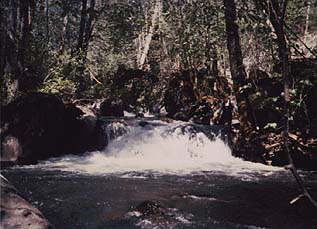 |
|
Water Temperature: Increased flows since 1995 have demonstrated that 30 cfs can keep water temperatures in the lower North Fork Battle Creek suitable for winter run and spring chinook. TRPA (1998) modeled the effect of increased flows on temperature. Outputs suggest that all accessible reaches of the North Fork and several in the South Fork would become good to excellent habitat for both winter run and spring chinook salmon. The average daily water temperature of the North Fork Battle Creek was optimal for winter run chinook spawning and spring chinook adults in May and June of 1996 at Eagle Canyon Dam and Wildcat Dam. The lowest reach of the North Fork was also habitable for these species. The flow releases in 1996 are similar to those anticipated under restoration and were sufficient to maintain cool water temperatures. |
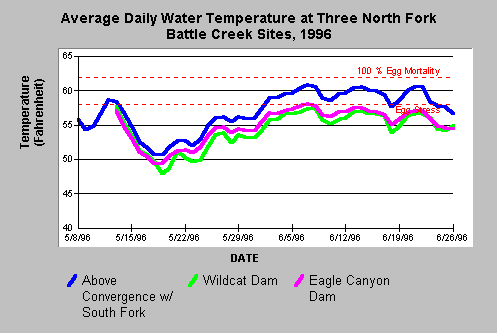 |
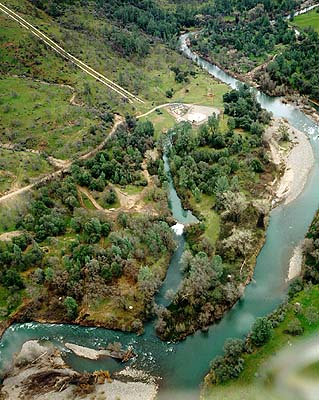 |
False Attraction and Straying: The Restoration Plan notes that water diverted from the North Fork to the South Fork may lead to straying of returning adult winter and spring chinook salmon. Since the North Fork is superior habitat, straying to the South Fork might decrease chances for survival. If these fish were attracted to the South Fork and then water diversion from the North Fork were disrupted, considerable mortality could result. The Restoration Plan calls for less water to be transported from the North Fork to the South Fork. Also North Fork water used for hydropower generation in the South Fork basin would be captured below each powerhouse and shunted to lower diversions for use in power generation, not mixed with South Fork flows. A barrier has already been constructed to block entry of salmon into the Coleman Powerhouse tailrace in order to prevent problems with false attraction. |
There are three types of
migratory barriers to salmon in Battle Creek: natural ones created by rock falls,
hydroelectric diversion dams and the Coleman Hatchery weir. The Restoration
Plan calls for improving fish passage at the hatchery weir while retaining the
ability to selectively block access . Ladders at dams are currently insufficient
and the Plan calls for removing dams where the cost of improving ladders and
other adjustments would be greater than decommissioning (Wildcat, Eagle Canyon
and Coleman dams). A fish migration barrier study (TRPA 1998b) identified flows
necessary to insure adequate adult salmon migration at natural barriers. A flow
of 30 cfs would allow winter run and spring chinook to negotiate most waterfalls.
One barrier at Panther Creek on the South Fork needs modification to open an
additional 2.5 miles of prime habitat to salmon. The Restoration Plan also calls
for modification of a barrier to steelhead in Baldwin Creek and for continued
monitoring of barrier formation in all of Battle Creek after major storms.
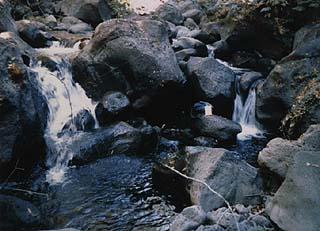 |
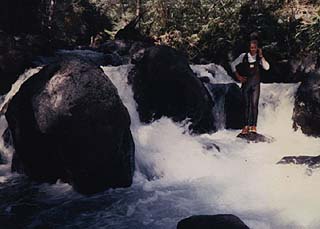 |
| The North Fork of Battle Creek at rm 10.79 in the Bailey Reach at a flow of 7 cfs on September 23, 1988. From the Thomas R. Payne and Associates Battle Creek Barrier Report. | This is the North Fork of Battle Creek at the same location at a flow of 90 cfs on April 20, 1989. With higher flows, waterfalls such as this are no longer barriers. |
The gravel supply in Battle
Creek is adequate for salmon and steelhead spawning, except that it is trapped
upstream of diversion dams. Dam removal will allow for natural routing of gravel.
In locations where dams have not been removed, the Restoration Plan calls for
trapped gravel to be deposited below dams when dredging occurs. Also gravel
supplementation of Baldwin Creek is recommended to increase steelhead spawning
areas. 
Control of Disease Transmission
The Coleman National Fish Hatchery needs a disease free water supply to insure safe rearing of millions of juvenile salmon and steelhead. The hatchery is building a facility to treat incoming waters with ozone. In the event that the machine should suffer mechanical failure, the Restoration Plan calls for a hatchery water supply that would be drawn from above reaches with high disease risk. The greatest disease risk comes from fall and late-fall chinook which spawn well below the North Battle Feeder Dam and Inskip or South Diversion Dams on the South Fork.
In the larger scope of
Sacramento River restoration activities, Battle Creek would provide a refugia
for winter run and spring run chinook salmon in years of severe drought.
Although Shasta Dam has been retrofitted to allow cool water to flow from the
bottom of Shasta Reservoir, the system will not prevent lethal conditions in
the main Sacramento River in all years. At present, the only population of winter-run
chinook occurs in the Sacramento River downstream of Shasta Dam. This population
is at risk of lethal water temperatures from 4 to 9 years out of every 100 years
and would likely be faced with stressful conditions from 9 to 21 years out of
every 100 years. Therefore, restoration of the Battle Creek population of winter
run is extremely important to guard against catastrophic loss of the whole winter-run
species. Securing a refuge area in Battle Creek follows
current thinking on restoration strategies (Bradbury et al. 1995). Original
efforts to mitigate for the effects of Shasta Dam on spring chinook in the 1940's
and 1950's were largely unsuccessful (Richardson 1987, Black 2001). Actions
taken under this Restoration Plan will help make up for this short coming.
![]()
References
Black, M. 2001. Shasta salmon salvage efforts: Coleman National Fish Station on Battle Creek, 1895-1992. In Contributions to the Biology of Central Valley Salmonids. Volume 1. California Department of Fish and Game, Fish Bulletin 179. Performed under U.S. Bureau of Reclamation and Metropolitan Water District of Southern California contract for the Battle Creek Technical Advisory Work Group by Kier Associates. Sacramento, CA. 92 pp. [1.1Mb]Bernard, D.P., A. Gunther, E.Laychak, C. Darling. 1996. Restoring Central Valley spring-run chinook salmon populations: Technical Workshop to Identify Candidate Programs and Projects for Category III Funding. Prepared for Category III Steering Committee and CALFED Bay-Delta Program. 28 pp. + table.
Bradbury, B., W. Nehlsen, T. E. Nickelson, K. M. S. Moore, R. M. Hughes, D. Heller, J. Nicholas, D. L. Bottom, W. E. Weaver, and R. L. Beschta. 1995. Handbook for prioritizing watershed protection and restoration to aid recovery of native salmon. Portland, OR. 49 pp. [1.17Mb]**
California Department of Fish and Game (CDFG), 1990. (Excerpts from) Central Valley salmon and steelhead restoration and enhancement plan. Prepared by F.L. Reynolds, R.L. Reavis, and J. Schuler for CDFG, Inland Fisheries Division . Sacramento, CA. 83 pp. [1.25 Mb]**
McEwan, D. and T. A. Jackson, 1996. Steelhead restoration and management plan for California. California Department of Fish and Game, Inland Fisheries Division. Sacramento, CA . 244 pp. [3.2Mb] **
Payne, T.R. & Associates. 1998a. Battle Creek Fisheries Studies. Task 1: Instream Flow Study. Prepared for California Department of Fish and Game, Redding CA. Prepared by Thomas R. Payne & Associates. Arcata, CA. 56 pp. without figures, tables, or appendices.
Payne and Associates, 1998. Battle Creek fisheries studies. Task 4: Surveys of barriers to the upstream migration of anadromous salmonids. Prepared for California Department of Fish and Game, Redding CA . Arcata, CA. 22 pp. [56kb]**
Richardson, T. H., 1987. An analysis of the effectiveness of the mitigation plan for Shasta and Keswick dams. U.S. Fish and Wildlife Service, Division of Ecological Services. Sacramento, CA. 44 pp. [850kb]**
Ward, M. B. and W.M. Kier, 1999. Battle Creek salmon and steelhead restoration plan. Prepared for the Battle Creek Working Group by Kier Associates. Sausalito, CA . 157 pp. [1.4 Mb]